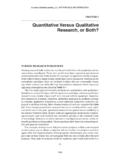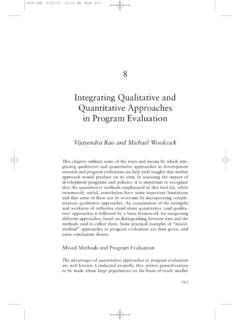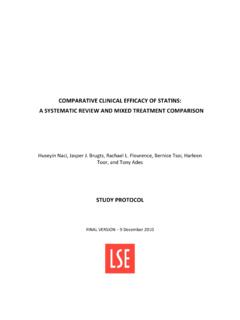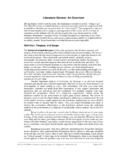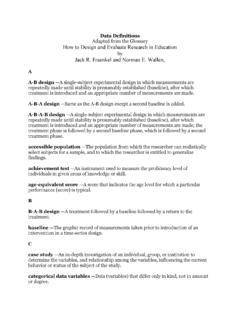Transcription of The Comparative approach: theory and method
1 2 The Comparative approach : theory and method Introduction In this chapter we shall elaborate on the essentials of the art of comparing by discussing relation between theory and method as it is discussed with reference to the Comparative approach . In order to clarify this point of view, we shall first discuss some of the existing ideas about what the Comparative approach is in terms of a scientific undertaking. In addition, we shall argue in Section that one can distinguish in Comparative politics a core subject that enables us to study the relationship between politics and society in a CONTENTS Introduction Comparative Research and case selection The Use of Comparative analysis in political science: relating politics, polity and policy to society End matter - Exercises & Questions Further Reading fruitful and viable way.
2 In section we shall enter into the important topic of the Comparative approach , the Comparative method and its implications for a proper research design. The central argument will be that a coherent framework of theoretical references and a corresponding logic of inquiry are required. If it is not possible to do this, the Comparative approach will still remain a valuable asset to political and social science, yet any claim of being a scientific approach should then be put to rest (Mayer, 1989; Keman, 1993a; Lane and Ersson, 1994).
3 A final concern involves scrutinizing existing logics of Comparative inquiry to account for the observed variation by means of testing empirical hypotheses, thereby either corroborating or falsifying them (Lijphart, 1975: 159; Przeworski and Teune, 1970; Guy Peters, 1998). Hence we explicitly aim at the relation between proposition and empirical evidence and consider that as the cornerstone of social science. This implies the use of positive theory development as a stepping stone to advancing our knowledge of politics and society.
4 The central feature of this approach to social science is embedded throughout this book by the relationship between Research Question, Research Design and -- empirical -- quantitative data-analysis on the basis of statistical methods . All these concerns are in itself worthy of serious discussion and deliberation, and the main issue at hand is that the Comparative approach often lacks coherence in terms of a set of theoretical references and related logics of inquiry. Therefore this chapter must be seen as an argument to relate theory and method in order to gain a viable and feasible approach to explain political and social processes.
5 To this end we propose the following guidelines to define the Comparative approach as a distinctive way of analyzing and explaining social and political developments. The guidelines can be considered as flags that mark the process of doing research by means of the Comparative method : 1. describe the core subject of Comparative inquiry. In other words: the question what exactly is to be explained and how do we recognize a need for comparison, that is: what are the essential systemic features? 2. develop a view on which theoretical concepts can travel comparatively as well as measure what is intended (internal validity) as well as possess a unifying capacity for explaining political and social processes in general (external validity)?
6 3. discuss the logic of the Comparative method as a means to a goal, rather than as an end in itself. In other words, which instrument fits the Research Questions to be answered best by means of what type of Research Design? We therefore now turn to the next point on the agenda: the Comparative approach as an important instrument of researching the relationship between politics and society. Comparative Research and case selection Comparative political and social research is generally defined in two ways: either on the basis of its supposed core subject, which is almost always defined at the level of political and social systems (Lane and Ersson, 1994; Dogan and Pelassy, 1990; Keman, 1997), or by means of descriptive features that claim to enhance knowledge about politics and society as a process ( : Roberts, 1978; Macridis and Burg, 1991; Almond et al.)
7 , 1993). These descriptions are generally considered to differentiate the Comparative approach from other approaches within political and social science. Although it is a useful starting point, it is not sufficient. The Comparative approach must be elaborated in terms of its theoretical design and its research strategy on the basis of a goal-oriented point of reference, what exactly is to be explained. A way of accomplishing this is to argue for a more refined concept of politics and society and develop concepts that travel -- are truly Comparative -- and can thus be related to the political process in various societies (Collier, 1993; Landman, 2003).
8 In addition, a set of rules must be developed that direct the research strategy, aiming at explanations rather than at a more or less complete description of political phenomena by comparing them across systems, through time, or cross-nationally. At this point most comparativists stop elaborating their approach and start investigating, often however, without realizing that theory and method are mutually interdependent (Keman, 1993c; Stepan, 2001). For the goal of Comparative analysis is to explain those puzzles , which cannot be studied without comparing and which are derived from logical reasoning.
9 Hence, no Comparative research without an extensive theoretical argument underlying it, or without a methodologically adequate research design to undertake first and vital step in the process is to ponder over the relationship between the cases under review and the variables employed in the analysis (Landman, 2003; Peters, 1998; Keman, 1993c). There is a trade off between the two: in general the more cases one compares, the less variables are often available and vice versa (Przeworski, 1987; Ragin, 1987).
10 In Chapter 3 we shall elaborate this problem in full, for now it suffices to put forward that the conversion of Research Question (RQ) into a viable Research Design (RD) is confronting the researcher with this inevitable problem. To complicate things even more one has also to consider whether or not time is a relevant factor to be taken into account (Bartolini, 1993). Below in figure this problem of choice has been depicted. Figure ABOUT HERE. (NOT IN THE FILE; SEE BOOK PAGE 28) Figure shows that there are five options available: (1) The Single Case Study (either a country, an event or systemic feature) (2) The Single Case Study over time ( a historical study or time series analysis) (3) Two or more cases at a few time intervals ( closed universe of discourse) (4) All cases that are relevant regarding the Research Question under review (5) All relevant cases across time and space (pooled time series analysis) Obviously a single case study (see: Yin, 1996.)










